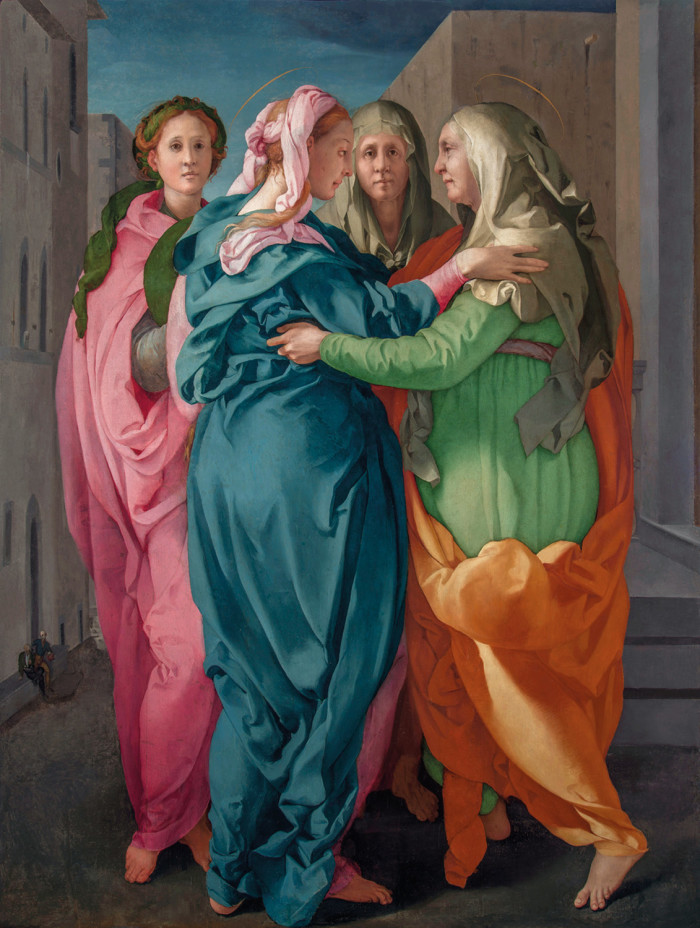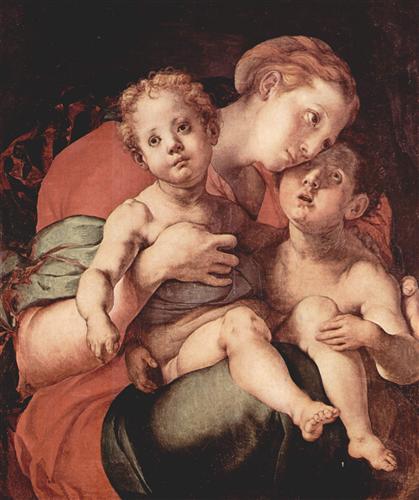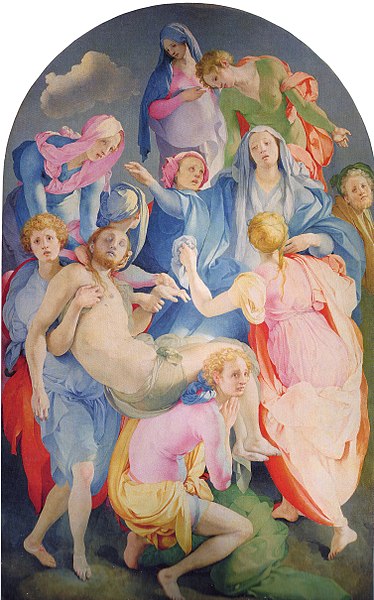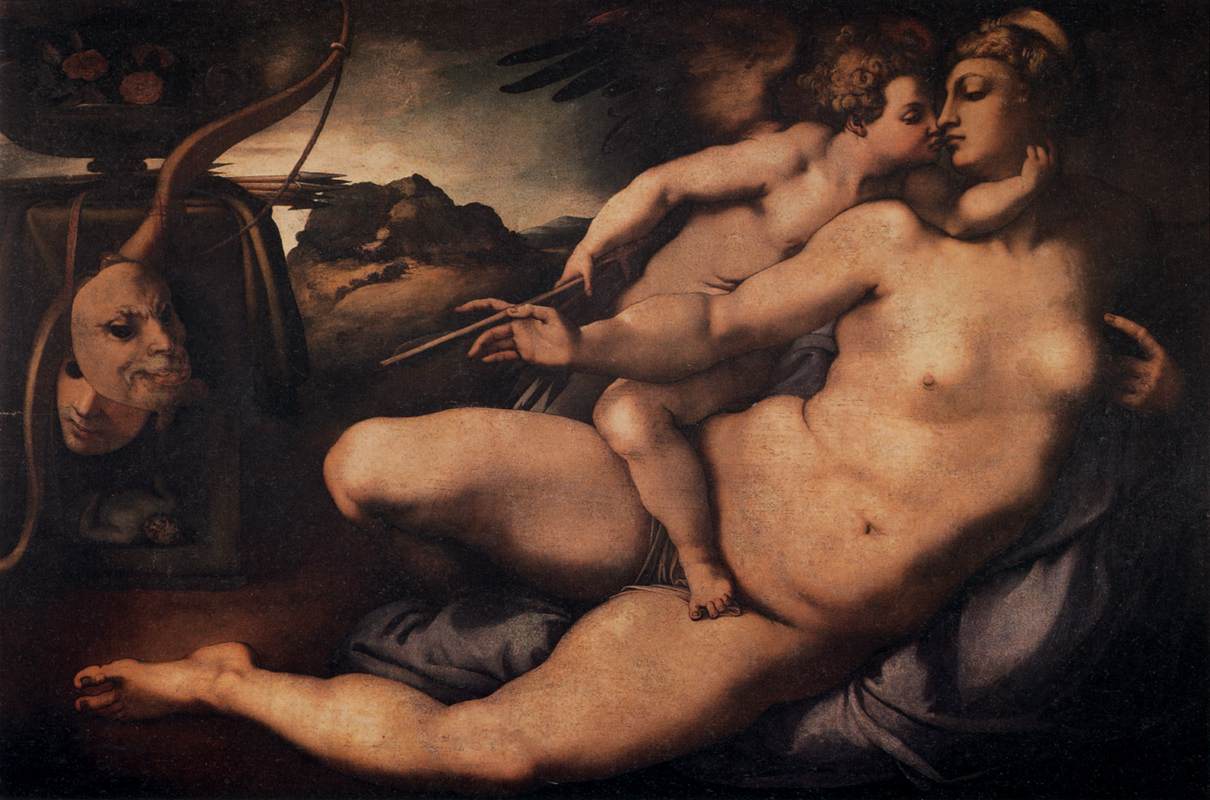
Pontormo was the son of Bartolommeo Carrucci, a painter. According to the biographer Giorgio Vasari, he was apprenticed to Leonardo da Vinci and afterward to Mariotto Albertinelli and Piero di Cosimo. At the age of 18 he entered the workshop of Andrea del Sarto, and it is this influence that is most apparent in his early works. An example of Pontormo's early style is a fresco depicting the Visitation of the Virgin and St Elizabeth, with its dancelike, balanced figures, painted from 1514 to 1516.

The Visitation is the visit of Mary with Elizabeth as recorded in the Gospel of Luke, Luke 1:39–56. It is also the name of a Christian feast day commemorating this visit, celebrated on 31 May in the West (2 July in calendars of the 1263–1969 period, and in the modern regional calendar of Germany as well as the Anglican Communion) and 30 March among Eastern Christians.
This early Visitation makes an interesting comparison with his painting of the same subject (below), which was done about a decade later for the parish church of St. Michael in Carmignano, about 20 km west of Florence. Placing these two pictures together—one from his early style, and another from his mature period—throws Pontormo's artistic development into sharp relief. In the earlier work.

In 1518 he completed an altarpiece in the Church of San Michele Visdomini, Florence, that reflects in its agitated—almost neurotic—emotionalism a departure from the balance and tranquillity of the High Renaissance. His painting of Joseph in Egypt (c. 1515), one of a series for Pier Francesco Borgherini, suggests that the revolutionary new style appeared even earlier.

The Joseph canvases offer another example of Pontormo's developing style. Done around the same time as the earlier Visitation, these works (such as Joseph in Egypt, above) show a much more mannerist leaning. According to Giorgio Vasari, the sitter for the boy seated on a step is his young apprentice, Bronzino.

This picture represents a mass slaughter, including a series of crucifixions in the background. The battle scene on the left side of the panel recalls Leonardo's cartoon for the Battle of Anghiari, known today only through copies. Elsewhere there are reflections of Michelangelo's work, including the cartoon for the Battle of Cascina. Nevertheless, Pontormo always retains his own voice. More on this painting
Pontormo was primarily a religious painter, but he painted a number of sensitive portraits and in 1521 was employed by the Medici family to decorate their villa at Poggio a Caiano with mythological subjects.

In the Passion cycle (1522–25) (above) for the Certosa near Florence, he borrowed ideas from the German artist Albrecht Dürer, whose engravings and woodcuts were circulating in Italy. His mature style is best exemplified in the Deposition (below) painted soon after this for Santa Felicità, Florence.

The figures are solid and well-defined, and the chiaroscuro, rendered with feeling, moulds the golden flesh surfaces with a yellowish light. More on this painting

This painting suggests a whirling dance of the grief-stricken. They inhabit a flattened space, comprising a sculptural congregation of brightly demarcated colors. The vortex of the composition droops down towards the limp body of Jesus off center in the left. Those lowering Christ appear to demand our help in sustaining both the weight of his body (and the burden of sin Christ took on) and their grief. No Cross is visible; the natural world itself also appears to have nearly vanished: a lonely cloud and a shadowed patch of ground with a crumpled sheet provide sky and stratum for the mourners. If the sky and earth have lost color, the mourners have not; bright swathes of pink and blue envelop the pallid, limp Christ. More on this painting

Pontormo executed this painting for the chapel of Francesco di Giovanni Pucci in the church San Michele Visdomini in Florence. The painting, usually mentioned as the Pucci Altarpiece, portrays the Virgin with St John the Evangelist, Joseph, holding the baby Jesus, the young St John, St Francis and St James, the latter being the artist's self-portrait.
The figures are arranged in two areas, divided by a vertical axis, which forms the height of a triangle, at whose apex is the Virgin's head.
The compositions of both the right part and the left part, although symmetrical and populated by an identical number of figures, are organized very differently. The complex twisting of the bodies and the many different directions of the gestures suggest the use of a grid of extremely complicated and dynamic geometrical schemes. The lines of vision go in all possible directions; in no instance do they cross or match, this emphasizing the psychological isolation of the figures. The facial features and expressions of the older Joseph and St John the Evangelist, as well as the laughing putti, are exaggeratedly pronounced. In short, everything combines to create an atmosphere of restless instability. More on this painting

Pontormo became more and more of a recluse in later life. A diary survives from 1554 to 1557, but the important frescoes in San Lorenzo on which he worked during the last decade of his life are now known only from drawings; in these the influence of Michelangelo is apparent. Numerous drawings survive, and paintings are to be found in various galleries in Europe and America, as well as in Florence. More on Jacopo da Pontormo
It is frescoed around the window on the wall adjacent to Pontormo's masterpiece, the famous Deposition from the Cross. Pontormo depicts the Annunciation, the revelation to Mary by the Archangel Gabriel that she would conceive a child to be born the Son of God, in a lively composition, with both figures in an elastic contrapposto. More on this painting

Please visit my other blogs: Art Collector, Mythology, Marine Art, Portrait of a Lady, The Orientalist, Art of the Nude and The Canals of Venice, Middle East Artists, 365 Saints, 365 Days,
and Biblical Icons,
also visit my Boards on Pinterest and deviantart
Images are copyright of their respective owners, assignees or others.
Some Images may be subject to copyright
I don't own any of these images - credit is always given when due unless
it is unknown to me. if I post your images without your permission, please tell
me.
I do not sell art, art prints, framed posters or reproductions. Ads are
shown only to compensate the hosting expenses.
If you enjoyed this post, please share with friends and family.
Thank you for visiting my blog and also for liking its posts and pages.
Please note that the content of this post primarily consists of articles
available from Wikipedia or other free sources online.



.jpg)
No comments:
Post a Comment